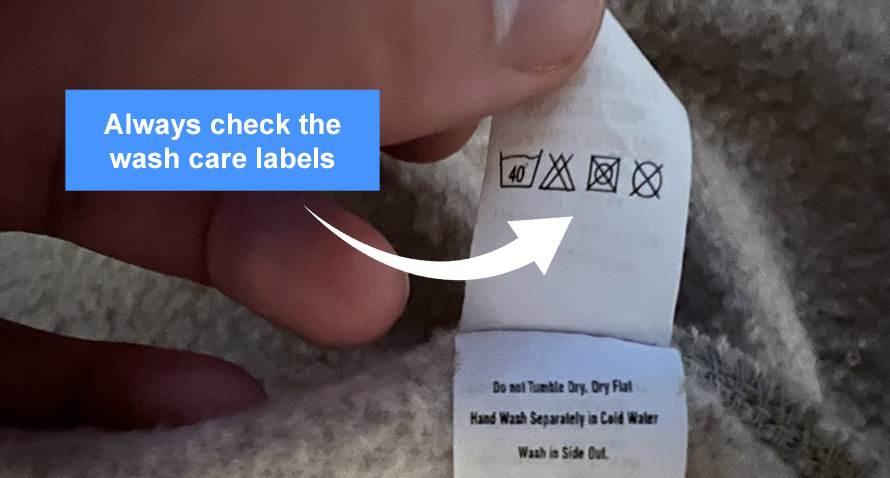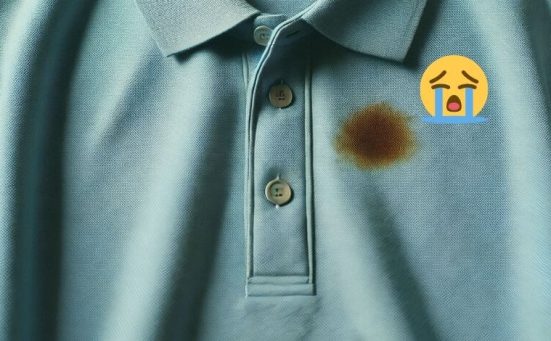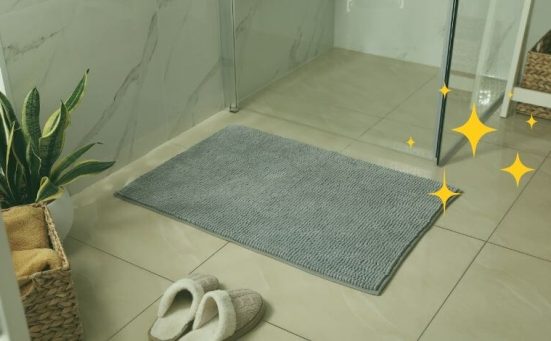
Can You Use Household Bleach On Your Laundry?
The short answer is yes, you can use household bleach on your laundry – sometimes.
In this article you’ll find out exactly how to use general purpose household bleach to help get your whites white. We’ll look at what household bleach is, whether it’s safe to use on your clothes and how to apply it.
What Is Household Bleach?
- Domestos Original Thick Bleach cleans and disinfects surfaces around your home
Household bleach is a strong, effective antibacterial and cleaning solution. Which is typically made from a mixture of 3 to 6 % sodium hypochlorite, hydrogen peroxide, sodium hydroxide, calcium hypochlorite and water.
It is also known as chlorine bleach which is created by reacting chlorine gas with sodium hydroxide.
It is not to be confused with oxygen bleach or sodium percarbonate as it’s also known as. Which is a far gentler, more environmentally friendly type of bleach and can often be used on coloured clothes as well as whites.
Household bleach is an irritant which can affect the skin and the eyes. Plus breathing in bleach fumes for any length of time can increase your risk of cancer.
You should never mix household bleach with any other chemicals because the gases formed can be fatal.
However you use household bleach, whether for cleaning around your home or in the laundry, you should exercise extreme caution.
How Does It Work?
Chlorine bleach works by preventing any stains from absorbing light. Which means the stain appears to be gone (as it’s invisible to the naked eye).
It does this by oxidising the bonds at a molecular level which destroys them. Chlorine bleach also deals with bacteria in the same way.
Can Chlorine Bleach Be Used On Clothes?
Chlorine bleach (household bleach) can be used on clothes under certain conditions. You will need to do the following if you intend using household (chlorine) bleach in your laundry.
Safety First
Before handling household bleach you should always wear gloves to prevent any bleach from burning your skin. It doesn’t matter how careful you are, accidents can, and do, happen. We recommend wearing an apron to protect your clothes too.
It is also advisable to lay something down to protect the surface you are working on from any spillage however small.
Check The Care Label

Care labels are there to advise on the best way to wash and dry your clothes to make them last longer. Your garment’s care label could have the words “Do Not Bleach” or more likely is a triangle symbol.
- Plain Triangle
If there is a plain triangle, it indicates that the garment can be bleached. - Triangle with diagonal stripes
This symbol indicates the garment can be bleached but only with a non-chlorine (household) bleach. - Triangle with an X over it
This symbol indicates that the garment cannot be bleached at all with any kind of bleach.
The Clothes Have To Be White Or At Least Colour Fast
To test whether the clothes are colour fast or not dilute 1 teaspoon of household bleach with 2 tablespoons of warm water. Then using a cotton bud apply some of the diluted bleach solution onto an inconspicuous spot like an inside hem or seam or inside a pocket.
Allow the spot to dry completely and check for any colour change. Another tell tale sign that the colour is likely to run is if there is any colour transfer onto the cotton bud.
If there is any reaction to the bleach mixture at all, don’t use bleach on that particular garment.
Household bleach should never be used on Wool, wool blended clothes, silk, rubber, spandex, Lycra, elastane, or many flame retardant materials. This is because it weakens the fibres and will cause them to break which will lead to holes appearing in those clothes.
Consult You Washing Machine User Manual
The user manual for your washing machine will give you specific instructions on how to use household bleach in your machine. In some cases bleach should only be added to the drum, in others it should be added via the dispenser drawer.
The Bleach Should Be Added To The Wash At The Correct Time
Household bleach should never be poured directly onto your clothes because it could not only ruin the colour or pattern, it could also damage the material.
Bleach is a corrosive compound and as such should be used responsibly.
We strongly recommend diluting chlorine bleach at a rate of ¼ of a cup (60ml) of bleach to a gallon (4.5 litres) of water before using in a wash load.
Plus the diluted bleach should be added to the liquid dispenser of the washing machine before the laundry is added. Then add detergent as normal.
Give Clothes An Extra Rinse
After washing your laundry using bleach, it is always best practice to give the clothes an extra rinse cycle. This is to ensure that all of the bleach has been removed from the clothes.
There are 2 reasons for this, one is the continuing corrosive action of the bleach on the fibres of your clothes. And the other is the fact that bleach can be an irritant especially to sensitive skin.
Use Fresh Household Bleach For Best Results
Liquid bleach has a limited shelf life, which means that once the bottle is open, and exposed to the air it has around 6 months before it loses its efficacy. Which means after 6 months liquid chlorine bleach is likely to not be as effective at removing stains or disinfecting clothes.
Never Mix Household Bleach With Other Chemicals
Household bleach should never be mixed with other cleaning products which contain any of the following;
- Ammonia
- Acids
If household bleach mixes with any of the chemicals mentioned above, the results could be fatal.
The combination of household bleach and certain acidic substances which are often found in household cleaners for example, can produce a poisonous gas which can make you severely ill or in extreme cases cause death.
The Best Way to Remove Stubborn Stains Using Household Bleach
If your garment is bleach safe, and the stain is relatively small, you can mix 1 teaspoon of bleach with 2 tablespoons of water. Then using a cotton bud or piece of old cloth simply dab the stain with the bleach solution.
Allow the bleach to soak in and then wash the garment in the usual way in the washing machine. Taking care to not add any clothes that cannot be bleached in the same wash.
For more stubborn stains, the best way to remove them is to soak them in a bleach solution. Fill a gallon (4.5 litres) bucket with warm water and mix in ¼ of a cup (60 ml) of household bleach.
Completely submerge the stained garment(s) and soak for up to 15 minutes. Then remove the clothes from the bucket and wash in the washing machine on a regular cycle.
An extra rinse is advisable to completely remove any lingering traces of bleach from the clothes.
What Is Laundry Bleach?
- Specifically formulated to work better on lighter fabrics; ACE for Whites helps brighten dull whites while still being gentle on delicate clothes.
Laundry bleach is made from the same chemicals as household bleach but sold in a diluted form. Which makes laundry bleach a safer alternative to household bleach.
However, it should never be used on silk, wool or coloured clothes and you should always wear gloves when using laundry bleach.
You should add laundry bleach to the dispenser drawer of the machine or as directed on the bottle’s label or washing machine’s user manual.
Alternative Ways To Remove Stains & Whiten Clothes
If you don’t have any household bleach, or you think it might be too harsh, there are a few alternative ways to remove stubborn stains and whiten your clothes. These include;
Distilled White Vinegar For Removing Stains
- ECO FRIENDLY NATURAL WHITE VINEGAR - Our vinegar has natural cleaning properties without any chemical components which could lead to nasty residue. Tradionally, Vinegar is the original & best cleaning product!
Distilled white vinegar is a cheap, natural, less harmful alternative to household bleach and in many cases, it removes stains from clothes.
All you need to do is add 1 cup to the rinse cycle to help remove those stains from your clothes. As white vinegar isn’t actually a bleaching agent, it can be used in a mixed wash without affecting colours.
Never mix white vinegar with household bleach, vinegar is acidic and should never be mixed with chlorine bleach, the results could be fatal.
Baking Soda (Soda Crystals) For Brighter Whites
- Packaging Info: Cardboard recyclable.
If your white clothes have lost their brilliance, sprinkle ½ a cup of baking soda on top of the clothes directly in the drum of the machine, add your usual detergent and run your regular wash cycle.
It will also help to remove stains and can be used on colours as well as whites. Not only does baking soda help to brighten your whites, remove stains and remove odours from your clothes. It also acts as a fabric softener as well.
SEE ALSO: How To Make White Clothes White Again (they’ll look new)
Frequently Asked Questions
You can use regular bleach, also known as chlorine bleach or household bleach in laundry. It needs to be diluted as it is too strong to use neat. Using neat regular bleach will damage your clothes by burning through the fibres and creating holes. It should also never be used on coloured garments as the colours would change in patches.
You can put household bleach in a washing machine. You can add ½ a cup to the detergent dispenser and run a normal wash cycle to eliminate germs and bad odours. Be sure to run an extra rinse cycle before washing any clothes to be certain that all residue bleach has been removed.
There is no difference between household bleach and laundry bleach except sometimes, laundry bleach has been diluted. Often laundry bleach has a more perfumed smell too, but you need to check the bottle for how to use laundry bleach in the wash.
Nothing bad will happen if you mix bleach with laundry detergent. Which means it is safe to use bleach with laundry detergent. However, you should check whether the garments can tolerate bleach before use.
Bleach should not be put in the fabric softener dispenser because this would not allow enough rinsing to remove the bleach from the clothes. Bleach should be put in the detergent dispenser during the initial water fill.
Also, follow us on Pinterest ...







